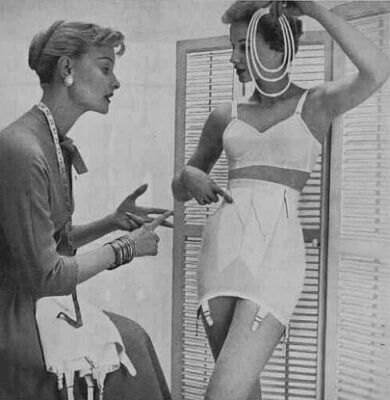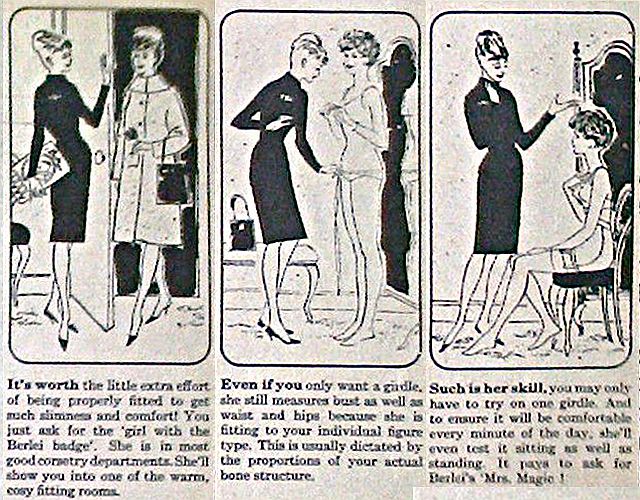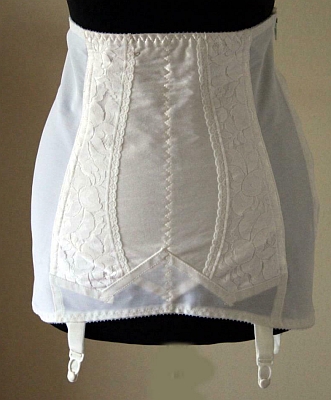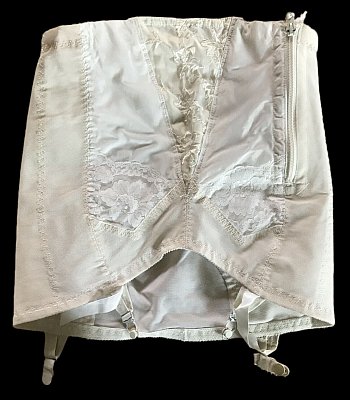|
I used to know little about Berlei other than their incredibly
successful 'Gay Slant' range of girdles (below right) and pantie-girdles. As other
manufacturers modernised their range, Berlei continued to provide traditional girdles in a good variety of
fittings right up to the late 1980's. Berlei employed professional corsetieres
to chose the correct combination of fittings from their range much the way
that Camp did.
Berlei
was initially Australian and the name derives from the
original firm's accountant Fred Burley, who married the firm's manageress in
1907. The name was registered as Berlei some years later. Another famous brand, Sarongster, seems to have merged with Berlei, or was a part
of Berlei as the advertisements below reveal.
One of Berlei's claims to fame was
its approach to sizing. Probably not as unique as they claimed, it did at least
admit to the remarkable range, not just of sizes, but of shapes and forms that
women possess. This was called the "Berlei System" and was in use,
albeit attenuated, in the British High Street in the 1980's.
 
|

|
A history of Berlei can be found on
the firm's archives:-
Collected Archives Administrative
History
|
On 25
August 1910 Frederick Richard Burley (1885-1954), with financial support
from his family, bought a controlling interest in E. Gover & Co, a small
women's undergarment firm in Market Street, Sydney. During 1911 a decision
was also made to enter into the wholesale trade. On 1 July 1912 Fred
Burley's brother, Frank Arthur Burley (1881-1957), joined the firm and the
wholesale section was formed into a separate company, Unique Corsets Ltd,
which had a nominal capital of 10,000 pounds and paid up capital of 2,500
pounds. The first meeting of the company was held in October 1912.
Unique Corsets Ltd rented the top floor in a building in Wilmot Street and
employed 12 people. In its first four months the company generated sales of
1,605 pounds and its output was only limited by the number of trained
machinists it could employ. Total sales for the first 12 months were 10,500
pounds.
In
1913 Fred Burley made a study tour to Europe and the United States of
America to view latest developments in the industry. In 1915 Mary Craven,
formerly manageress of her father's undergarment factory, joined the company
as Designer and soon afterwards was sent overseas on study tour. This was
part of a considered strategy to bring senior management up-to-date with
industry trends and advances.
The
business continued to grow and another floor was rented in the Wilmot Street
building. By 1917 staff numbers had grown to 60 and new premises were
occupied in the Commerce Buildings, Liverpool Street, Sydney. In that year
Fred and Arthur Burley jointly coined the trade mark name 'Berlei'. By 1918
200 staff worked for the company and capital was increased to 15,400 pounds.
On 9
October 1919 Unique Corsets Ltd formally changed its name to Berlei Ltd as
the brand name was now well established in the public mind. Berlei Ltd was
registered as a public company in October 1920. In 1920 the company also
purchased W. Zander & Co, a corset manufacturer, which took total staff
numbers to 280. The company was re-floated with authorised capital of
250,000 pounds. On 1 January 1922 Berlei House, a seven storey office and
factory at 39-47 Regent Street, Sydney was opened. Daily output soon rose to
2,500 garments and staff numbered 500. Dr Grace Boelke was appointed Medical
Superintendent to ensure that Berlei garments were 'anatomically correct'
and to act as medical officer for the factory. The company was also known
for its enlightened approach to industrial relations influenced by the
Burley brother's commitment to community service.
During 1922 Fred Burley prepared a business policy and stated his ideals for
the company: "To Design and Manufacture Corsets and Brassieres of such
perfect Fit, Quality, and Workmanship, as will bring pleasure and profit to
all concerned, while at the same time rendering such excellent service to
our Clients and Consumers as will merit their permanent patronage." In 1923
Berlei took over one of its main competitors, Australian Corsets Ltd. On 27
November 1923 it also established Berlei New Zealand Ltd in Auckland.
Equipment was shipped from Australia and senior staff members were sent to
New Zealand to provide technical expertise in the establishment of the
business. Berlei New Zealand Ltd remained a subsidiary of Berlei Ltd from
its inception until 1929 when the holding company reduced its share-holding
and the New Zealand company entered into an "association" with its
Australian counterpart. While Auckland remained the headquarters for Berlei
New Zealand Ltd, a number of smaller plants were also opened in other parts
of the country. Branch offices were opened in Melbourne (1921), Brisbane
(1923), Adelaide (1929) and Perth (1929), and a factory was opened in
Melbourne in 1927. Training courses for retail corsetieres were begun by the
company in 1923 and during 1924 and 1925 Berlei promoted its products
through what it termed "artistic public demonstrations" in some of
Australia's larger theatres and in department stores. The
company was listed on the Stock Exchange in 1926.
For
many years Fred Burley had been concerned that women's underwear should be
designed to fit the shape of the female body rather than to match clothing
conventions of the time. In 1926 in collaboration with physiologists in the
Faculty of Medicine at the University of Sydney led by Professor Henry
Chapman and Dr S A Smith Berlei undertook an anthropometric study of 6,000
Australian women. It was termed the National Census of Women's Measurements
and cost 10,000 pounds. Twenty three different measurements were taken from
each woman, tabulated and the results analysed. This led to the development
of the Berlei five figure type classification scheme - Sway Back, Hip,
Average, Abdomen, and Short Below Waist - and the "figure type indicator".
This indicator device was sent out to retailers who would take the
customer's exact measurements and then use them to classify the woman's
figure for product selection. |

|
On 5
January 1930 Berlei UK Ltd was founded as a subsidiary of Berlei Ltd and
registered as a public company on 10 February 1930. Its head office was in
Regent St, London, and it rented a factory near Slough. Fred Burley as a
director of the company from its inception, moving to England with his family in
1932 and becoming Governing Director of the Berlei group. Arthur Burley was made
Managing Director of Berlei Ltd in Australia. Mary Craven, who had been the
company's Head Designer, was transferred to England where she served as Managing
Director until 1935. In that year Berlei UK Ltd became the European agents for
Berlei Ltd Australia and Berlei New Zealand Ltd, providing it with an additional
source of revenue. However it took ten years from the time of its establishment
before Berlei UK Ltd made a profit and Fred Burley was ultimately to remain in
England for 15 years. In 1936 Berlei UK Ltd commissioned the architect Sir John
Brown to design and build a factory and new head office just outside Slough.
Designed in the International Modern style, the building was considered to be
one of the finest buildings of its time.
During
the 1930s Berlei developed its export market. Apart from exporting to the United
Kingdom and Europe, it also sold its products in South Africa, the Middle East,
the East Indies and South America. It also entered into agreements to
manufacture and sell leading overseas brands in Australia. One of these
agreements concerned Warner Brothers's "Le Gant" foundations. In association
with Hedley Jarrett, who had obtained the rights for Warner Brother's products
in Australia, Berlei formed Warner's "Le Gant" Pty Ltd. Subsequently Jarrett was
killed during World War II while on active service with the Royal Australian Air
Force and Berlei bought the balance of the shares from his estate. Throughout
World War II Berlei continued manufacturing its most popular lines as well as a
range of functional undergarments for members of the armed forces. It also
manufactured other items including khaki shorts.
Fred
Burley returned to Australia in 1947 and from then on both brothers gradually
withdrew from active day-to-day management of the company. In 1948 Arthur Burley
resigned as Managing Director and in January 1949 Fred Burley also announced his
retirement. John G Hurley and Harry W Arthy became joint managing directors of
the company. Fred and Arthur Burley both maintained positions on the Board of
Directors with Fred being made Chairman in July 1950 and Arthur Vice-Chairman.
Fred Burley died in 1954. Arthur Burley who succeeded his brother as Chairman of
Directors, died in 1957.
On 19
December 1951 shares in Berlei New Zealand Ltd were transferred to a holding
company, Berlei Industries Ltd. In 1957 Berlei Ltd was restructured with the
establishment of a holding company, Berlei United Ltd (Australia), which was
separated from the company's manufacturing and trading operations. This enabled
the directors to concentrate on expanding the company internationally. Berlei
Ltd
carried on as the main Australian subsidiary.
In mid
1966 tragedy struck when Keith Burley, Joint Manager Director of Berlei (UK)
Ltd, and Rex Moore, Managing Director of Berlei New Zealand, were killed in a
car crash in England. The loss of these two senior executives had a significant
impact on the operations of the group. In 1969 Dunlop Olympic Limited acquired
all the issued capital of Berlei. The Australian and New Zealand assets of
Berlei were sold to the Hestia Company Ltd and the name of the company was
changed to Berlei Hestia Limited. In 1986 Dunlop Olympic Limited became Pacific
Dunlop Ltd and
established a division known as Pacific Brands. In the same year Berlei was
incorporated within Pacific Brands. In 1985 Berlei UK Ltd went into receivership
and was purchased by Gossard Ltd, part of Courtaulds Textiles.
In the 1930's, Berlei
introduced the concept of different figure shapes.



It is one thing to be scientific, but the poor client on the right looks like
she has stepped into a doctor's surgery.




Even their
advertisements shown at the movies involved the 'type indicator'. This was a
Berlei feature that persisted for over six decades. Long after other brands has
abandoned all but waist sizing (except for the bespoke houses like Spirella),
Berlei offered different lengths and hip-springs. Look at the sheer number of
boxes carried by the saleslady in this 1930 reel.




and made an
advertisement in 1930 about fitting a rather lovely satin corselette on such a
slight woman that it was probably the last thing she actually needed but would
almost certainly have worn in those days.
Berlei used the
'before and after' technique to lure their clients, however, their attempts were
somewhat less believable than most.




I thought that these might be before and after poses but I believe that they
were just examples of what was on offer and that Berlei could do better (lady on
the right?)



Definite before and
after poses here. The face colour might just be embarrassment from having to
stand on a plinth.


All models were
scrutinised by fashion experts and, in 1940 during the war, the materials had to
be robust yet not to detract from essential war supplies (above).
|

|
Berlei, like many firms in the pre-war period, was not
immune to exaggerated 'before-and-after'
advertisements. Similarly, the fad at the time for 'patent' miracle devices,
was not lost on the corsetry trade; it probably never has been! Berlei never
resorted to latex corsets, but they did try cluster-lacing with their
"amazing Controlacing Berleis."


 |






These pictures from
the Berlei archives (1930's) are most interesting. The patented Berlei 'Controlacing'
arrangement looks very much like Samuel Higby Camp's invention. Amazingly, the
picture second from the right is identical to that from the American Camp
brochure of 1941, page 39 of Dorsolumbar supports! This presumably was one of
the agreements whereby Berlei could sell international marks under licence.
Further evidence of this can be found in the following Berlei advertisement:


"Camco" is just a bit
similar to Camp and the 341 is even a Camp model designation.
In the post-war
period, we see a departure from the larger woman, desperately in need of
Australian engineering know-how to pull her into shape, and the more motherly,
realistic women makes an appearance. The 'will power' advert is a classic. You
dispense with will power and eat as much as you like, secure in the knowledge
that your Berlei panty-girdle will return you to that perfect size.






Even in the 1960's,
the various figure types and styles of garment were key to Berlei's success.
The Berlei Australian
Fitter's magazine of 1958 shows these two vignettes (below). They almost give
the appearance that the photographer walked in off the street and just took a
few snaps. Perhaps that was the case!
|

 |

These shop scenes range from what appears to be a
provincial retailer to a city department store. The right hand scene was
taken from a TV commercial that depicted the pretty young sales assistant
carrying a girdle display to put in the wndow. As she skips through the
shop, she straddles the banister of the stairs and slides gracefully towards
the display. In these day of HSE, such conduct would merit instant
dismissal!
Note the use of the term 'step-ins' rather than girdle and
also that in the name 'gay Slant', the 'g' in 'gay' is in lower case. |


Note that on the right hand picture, the Berlei type indicator is clearly in
evidence.
|
I have included more
pictures from this magazine (below) because I think they illustrate so clearly the
interaction between the corsetiere and the client. The approach is subtly different from Spencer. Here the client has no defects or bulges; she
simply looks good in her girdle. On the right, Berlei reveals the
secret of its success. Not made-to-measure like Spirella and Spencer, but a good
range of fittings in the popular corselette, girdle and pantie-girdle. The
message reached every corner of the market.


 

The relationship of the corsetiere and the
client. All the photographs above and below come from the Berlei Australian
fitters' magazine of 1958.
|
|
 |
|

Berlei go to the length of creating 'Mrs. Magic', the corsetiere. In real
life, I wonder if they ever imagined that one of their staff would be called
 |







Latterly, all the models were young
women, as the company desperately sought to replenish its market. The daughters
of the 'realistic mothers' (above) failed to buy girdles
and corsets. A diet of outdoor sport, the post-war hardships forgotten and
varicose veins easily treatable, meant that the new generation didn't require a
strong foundation. The Australian climate in summer didn't help either. Names
like 'Youthline' and 'gaySlant'
failed to attract the numbers required. Despite that, some of the advertisements
were classics. I love the poor Australian lady, Mary Powers. Note as well that
Berlei invented another spelling for panty or pantie and now pantee.
Regard the advertisement
on the left. Stylish and elegant certainly, but note the artist's exaggeration
of the satin sheen of the panels. It might seem simply a highlight of the
picture (which it is), but Berlei knew the power of satin
as a male attractant and used any advantage to sell its wares.
|
The gay Slant Girdle
Berlei's last great success was the 'gay Slant' girdle and below and middle we
see the quintessential Berlei girl who certainly did not need a girdle.

 
Note the use of the euphemism 'step-in'. The word 'belt' was also used, in fact,
anything to avoid the G-word.
|
 |

The classic
'gay-Slant' still sold today, but rarely.
It would seem that the model is daring you to buy one!
In their day, they were quite popular. Cheaper than the made-to-measure
girdles from Spirella, they could be ordered in a whole variety of sizes,
lengths and hip-springs to fit all figures. This made them a touch more
expensive than the offerings from Marks & Spencer
but some women liked the variations available from Berlei. |

The 'gay Slant' motif
could be purchased as a corselette, girdle or panty-girdle, one of the
high-waisted panty-girdles rare in the UK but more common in the USA.
Berlei Advertisements
|

|

|
I do not know why the lady stands
on her head.
"You are old Mrs. Williams",
the corsetiere said "and your hair has become very white
and yet you incessantly stand
on your head; do you think at your age this is right?"
"In my youth", Mrs Williams
replied to Berlei, "I feared it might injure the brain
but now I am perfectly sure I
have none; why - I do it again and again!"
with sincere apologies to the
Reverend Charles Lutwidge Dodgson
I can only guess that the
inverted position of the poor lady is meant to represent the spinning of the
Berlei measuring wheel or 'type indicator' as they liked to call it (see
above). Mind you, it did not matter much where the arrow pointed since you
had either big hips, a big abdomen, sway back or were short below the waist.
There is no such thing as a woman who could not benefit from the
ministrations of a good Berlei girdle.
We painstakingly returned the
poor women to an upright position and I don't think the advert loses out at
all, however, it ceases to be eye-catching and I suppose that was the whole
point.
To be honest, for a mass-marketed
product, Berlei did offer a good range of fittings at the high street stores
well into the 1980's. |

|




From left to right we
progress from 1946, through 1953 to the early 1960s; girdles are de rigeur.




But between 1963 and
1964, we greet the dawn of the panty-girdle that would herald the end of the
lower foundation garment less than a decade later.
In 2018, Berlei is
still active in the world of bras.


I recently came across a beautiful example of an early Berlei
corset (courtesy of Sewing
Machine Girl).
|

 |
 
An extremely
well made example of a mainstream front-lacing corset in elegant, yet
hard-wearing, corset quality satin brocade. Note the internal panel that would protect the wear's abdomen from the
laces, and how it stops short at the lower loop so that the wearer could
sit in comfort. |
Another lovely
example of a satin girdle.

The rubber-based elastic dates this piece to the late 1950's. |
 
|


Panty-girdles,
girdles, girdles with that extra waist cinch and corsets; Berlei made them all.
Boring Backs
This Berlei girdle
from the 1970s is a good example of the declining style of girdles that took
place from the end of the 1960s into the 1980s.
The front view is
still very pretty with lace detailing (Berlei never went in for satin in the gay
Slant girdles), but the rear is simple bland elastic and the zipper and
suspenders are formed from a nasty nylon plastic.





Why is it that
latterly, girdles and Berleis in particular,
have such pretty fronts and such plain, dull and boring
backs? It is a common feature and we commented on it in our
French pages. Is it simply that
the view in the mirror will look pleasing and the
manufacturer can save money on the rear? According to my
husband, the rear view of a down-stretch satin panel at the
back of a girdle is worth the expense but he's an engineer,
not a manufacturing accountant. One thing is for certain,
the rear bones on the that Berlei are going to show through
all but the thickest of fabrics!
Another failing of Berlei's girdles
were the bones that would take up a curved shape particularly if you removed the
girdle by inverting it as so many women did.
At the Powerhouse
Parramatta, the Museum of Applied Arts & Sciences, in Western Sydney, Australia
is an exhibition of 350 years of underwear that features items from Berlei as
well as some of the V&A, London collection.




The ladies on the left
are not from Australia, but from the Berlei brassiere factory in Ebbw Vale,
Wales (1951).









































































































